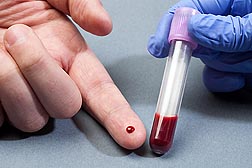Improved Vitamin B12 Test May Help Young and Old Alike
Listen to podcast.
Vitamin B12 helps your body perform many vital chores, including forming healthy red blood cells; keeping your brain functioning smoothly; and processing (metabolizing) the fats, proteins, and carbohydrates in foods that you eat.
Like all vitamins, B12 is a micronutrient, meaning that we need it in only very small amounts.
We get B12 from animal products—meats, fish, poultry, eggs, cheese, and yogurt, for instance—or from B12-fortified foods, notably breakfast cereals. We can also obtain it from nutritional supplements, such as B12 tablets or multivitamin pills. People who need to boost their B12 levels quickly may do so via shots or other means prescribed by their physicians.
In the United States, the very young and the elderly are among the groups at risk of becoming B12 deficient. Newborns whose mothers are deficient in the vitamin may begin their lives with low stores of it. The problem may be compounded if these babies are breastfed, because the B12 levels in their mother’s milk may be inadequate.
Seniors may have a different set of problems. If they lack sufficient gastric acid in the stomach, for instance, they may be unable to absorb enough of the vitamin from their food.
Now, a team of Agricultural Research Service scientists based at the Western Human Nutrition Research Center in Davis, California, has developed and tested an improved method for measuring a marker, or indicator, of the body’s stores of B12 in blood. Importantly, the blood sample can be very small in volume.
That’s an advantage in both medical and research situations. For example, samples that are taken from newborns and infants for health examinations at a hospital, or perhaps for use by medical or nutrition researchers, are typically very small.
What’s more, a small amount of sample is often the norm in complex, large-scale studies in which samples from volunteers have to be allocated among many researchers, each of whom may need it for a different research purpose. These studies can help answer vital questions about the vitamin, such as: How does B12 contribute to growth and development in the first years of life? How does it affect brain function in our later years? What is the extent of B12 deficiency in the United States and in other countries?
Reliable Results in About 4 Minutes
The ARS team has shown that a specimen of only 25 microliters of blood plasma or serum—the equivalent of about one-half of a drop of water—can be analyzed with speed, accuracy, reliability, and precision using a leading-edge analytical technology, UPLC-ESI-MS/MS, short for ultra-performance liquid chromatography-electrospray ionization-tandem mass spectrometry. If the assay is performed using robotics, the sample could perhaps be as small as 5 microliters.
ARS researcher John W. Newman at the nutrition center led a collaboration that produced the assay. His team built on earlier work in which scientists elsewhere used an older technology, liquid chromatography-tandem mass spectrometry, to measure the same indicator compound, or biomarker, that Newman’s group selected, namely, methylmalonic acid, or MMA.
What is MMA?
MMA is a compound that can build up in the bloodstream if there isn’t enough vitamin B12 in the body for an enzyme, methylmalonyl-CoA mutase, to function properly. That’s why MMA is broadly accepted as a reliable marker of the B12 that’s functioning in your body, or what nutrition researchers refer to as your “functional B12 status.”
The 25-microliter sample size needed for the new MMA assay represents a 4- to 10-fold reduction in the volume of specimen required for other MMA-based B12 tests, says Newman. His team was able to reduce the required sample volume and, at the same time, increase precision and accuracy of MMA analyses, by using modern instruments and by carefully adjusting the procedures used to handle and analyze the tiny samples.
During the 4 minutes that it takes to process a sample, MMA molecules are subjected to a complex sequence of steps. Each step helps ensure that only MMA will be detected, identified, and measured.
Real-World Samples Examined
The team has tested the assay not only with samples containing known quantities of purified MMA, but also with serum samples collected from a real-world B12 study. In that study, blood samples were collected at three different intervals from 139 healthy female volunteers, age 20 to 59. Each volunteer received a B12 shot at the outset of the investigation and then took either a 500-microgram B12 tablet or a look-alike placebo every day for 3 months.
By the end of the study, the MMA concentrations in 86 percent of the unsupplemented volunteers were regarded as within normal range, as compared to 98 percent of those who were supplemented.
Newman, a chemist at the center and an associate adjunct professor in the Department of Nutrition at the University of California-Davis, collaborated in developing the MMA assay with Lindsay H. Allen, center director and an adjunct research professor of nutrition; and with three other ARS colleagues: chemist Theresa L. Pedersen, physical scientist William R. Keyes, and nutritionist Setareh Shahab-Ferdows. They documented their research in a peer-reviewed article published in 2011 in the Journal of Chromatography B.—By Marcia Wood, Agricultural Research Service Information Staff.
This research supports the USDA priority of improving children’s nutrition and health and is part of Human Nutrition, an ARS national program (#107) described at www.nps.ars.usda.gov.
John W. Newman and Lindsay H. Allen are with the USDA-ARS Western Human Nutrition Research Center, 430 W. Health Sciences Dr., University of California, Davis, CA 95616; (530) 752-1009 [Newman], (530) 752-5276 [Allen].
"Improved Vitamin B12 Test May Help Young and Old Alike" was published in the April 2013 issue of Agricultural Research magazine.








